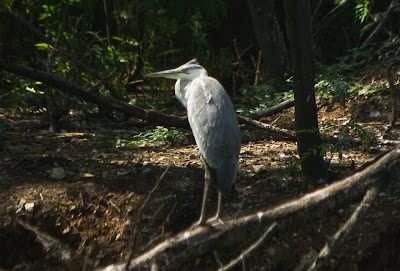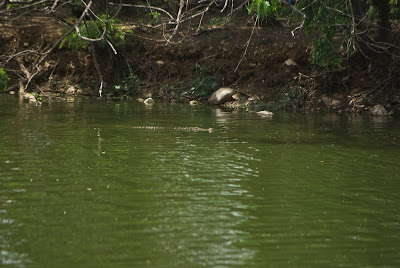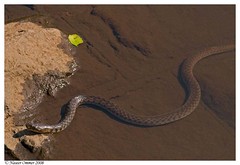 A juvenile Brahminy Kite?
A juvenile Brahminy Kite?My recent visit to Mysore was memorable in more ways than one. There was wonderful company of family, young and old, laughter, fun, memories and musings. Masala dosais, chocolate fudge and cappuccino.
 Karanji Lake. In the Nazarbad area. Restored in 2005, before which it had deteriorated, like all city water bodies, filled with sewage and garbage. ( So the notice board said, at any rate.)
Karanji Lake. In the Nazarbad area. Restored in 2005, before which it had deteriorated, like all city water bodies, filled with sewage and garbage. ( So the notice board said, at any rate.)
 By now the sun was beating down on us, and we decided to get off the water and into the shade offered by the lovely trees all around.
By now the sun was beating down on us, and we decided to get off the water and into the shade offered by the lovely trees all around.
 We then reached a watch tower, which seemed reassuringly sound and sturdy. We climbedsay, three-storeys up, and had a lovely panoramic view of the lake and the flight of the birds, as they glided in to land on the trees, or took off on another fishing mission.
We then reached a watch tower, which seemed reassuringly sound and sturdy. We climbedsay, three-storeys up, and had a lovely panoramic view of the lake and the flight of the birds, as they glided in to land on the trees, or took off on another fishing mission.
Its a city that I love to visit. The people are oh-so-gracious, the roads are tree-lined, and there are so many neighbourhood parks.
This time, I discovered a little jewel, though, just around the corner from the Ginger hotel where we stayed. An added bonus.
 Karanji Lake. In the Nazarbad area. Restored in 2005, before which it had deteriorated, like all city water bodies, filled with sewage and garbage. ( So the notice board said, at any rate.)
Karanji Lake. In the Nazarbad area. Restored in 2005, before which it had deteriorated, like all city water bodies, filled with sewage and garbage. ( So the notice board said, at any rate.)And now, teeming with life - water birds, garden birds, butterflies, fish, raptors and even crocodiles! Quite amazing!
And to add to our enjoyment, there are these pedal boats you can hire and take onto the water, in a designated area, not too close to the trees with nesting birds, but close enough to see this darter drying its wings, while a spot-billed duck kept it company.
My January trip to Bharatpur had given me enough exposure to this bird, and so I very airily and loftily informed the other members of my family about the Bird that craved for a ramp, its interesting fishing habits, and its gluttony!
Thankfully, the darters obliged me, and fished and ate in front of us, and I, ahem ahem, was the designated bird expert for the day! (Aunts are of some use, after all!)
There were whoops of amazement from my mother and niece and even my nephew was impressed by the darter's performance, as it swam with its periscope-like neck sticking out of the water, darting underneath only to emerge with a fish in its mouth, which it would then expertly toss down its gullet.
A spot-billed duck paddled serenely by in the water. The males have a little red "bindi" on the nose - its called a loral spot. And this male obligingly showed his spot to us!
 By now the sun was beating down on us, and we decided to get off the water and into the shade offered by the lovely trees all around.
By now the sun was beating down on us, and we decided to get off the water and into the shade offered by the lovely trees all around.We chatted away excitedly, and strolled on around the lake, my sister-in-law expertly reading the kannada boards with bird names for the purple moorhen and common coot giving us much amusement at the naamudhu koli and banna something else.
Boards every few meters cautioned us to "Beware of Snakes", and we did look around and make doubly sure before walking into the tall grass.
The water birds were intent on their morning breakfast.
 We then reached a watch tower, which seemed reassuringly sound and sturdy. We climbedsay, three-storeys up, and had a lovely panoramic view of the lake and the flight of the birds, as they glided in to land on the trees, or took off on another fishing mission.
We then reached a watch tower, which seemed reassuringly sound and sturdy. We climbedsay, three-storeys up, and had a lovely panoramic view of the lake and the flight of the birds, as they glided in to land on the trees, or took off on another fishing mission.Looking through the binoculars, we could see scores of nests of black-headed ibis, painted stork, spot-billed pelican, and egrets and cormorants.
The previous evening, I had clambered midway up, and enjoyed the sight of the pelicans coming in to land. It was like a scene from an aiport. Several of them circled in the sky above, then on some unseen signal one would come swooping down in a wide glide, circle the central island, and then land either in the water or on the "pelican island". I looked on as about five pelicans came in, in this fashion. It was quite a sight.
This morning, however, it was the painted storks that were in the air, and they glided and flew all over the lake, either rising to circle in the thermals above, or going back to their chicks in the nests.
We climbed down, and proceeded down the walkway to check out the butterfly park at the end of the walk. Sign boards urged us on, like milestones on a highway.
But there were distractions a plenty along the way, slowing us down.
A magpie robin cheekily hopped about on the grass, its tail twitching in curiosity, but it did not give us a nice song, which I quite like from that bird.
A pair of koels we spied, high up in the canopy, though their calls followed us all through the walk that morning. These birds, so common for us, lose their voices in winter, and its only in the heat of the summer that they regain their voices!
It is Mr Koel-of-the-black-body-and red eyes, who is responsible for the increasing ko-el, ko-el calls we hear, while the spotted-lady just emits a krrr-krr sound when she dashes off to another tree.
A grey heron posed for Sekar on a branch close to the lake, its hunched up neck giving it an air of discontent and moroseness.
Maybe he was having a bad morning? No luck with the fishes?
Quite different from the body language of the heron-with-a-fish!
A coucal skulked in the shadows, reminding me of the Ghana Ghouls in Ranjit Lal's The Crow Chronicles.
This was probably the Lesser Coucal. There is a Greater Coucal that is larger.
Their call resonates through forests all over India, and they seem to move around in a furtive fashion keeping to the shadows, unlike the bold and brassy robins. Funny, given that these birds are so much larger!
The Butterfly Park is a little island at the end of the walk, reached by a small walking bridge. Bushes and shrubs that attract butterflies have been planted, and walking around it, you see butterflies of all hues and colours!
My niece clicked away with her phone-cam in an attempt to get them framed for posterity, but they kept flitting around, refusing to sit still.
Finally she got this Common Tiger which sat for more than a second!
I wondered idly, if Valley of Flowers would also have butterflies...
I could quite happily have spent a few more hours there, but we all had to check-out, and so it was time to head back.
Similar silhouettes, different birds
The one on the extreme left is a Little Cormorant, the one in the middle seems to be a juvenile Indian Cormorant (called Shag in Salim Ali), with its brown head, and the one on the extreme right is the darter, with the snake-like neck and sword-like bill.
These birds have webbed feet, and quite happy swimming in ponds and lakes.
At this point, some of the group had gone ahead, and my son and nephew were discussing snakes and reptiles, of Ranganthittu. He (my nephew), pointed casually at the water and said, oh look, crocodile. So, I said, yeah right, nice try and all that, but anyway looked in the direction he was pointing...and there it was swimming away! I did a double take, looked again through the binocs, and yes it was a crocodile. Thankfully, before it vanished around the island, Sekar got a picture!
It was my first in-the-wild crocodile.
The guard informed us that there were several! Any croc rescued from a temple tank is released here, it seems!In my opinion, Karanji lake is a much more pleasant and enjoyable experience, than say Vedanthangal. The bund and area around the lake has been better planned. There are no screaming hordes of tourists and students out to have a good time...or did I go at a time when they were not around? Plenty of couples, but they minded their own business and did not disturb the birds, absorbed as they were with each other!
And no film music blaring in the neighbourhood. It appears that the Mysore Corporation has shut off the road outside the sanctuary to traffic in the night, and the barriers are removed only at around 8am. Also, visitors are allowed in only after 9:30 am, which gives the birds a good nights sleep.
So early morning birding is out of the question here, and the evening closing hours are 6 pm.
 Click on the picture, you can see the storks circling in the sky above
Click on the picture, you can see the storks circling in the sky above
 See the red loral spot of the spot-billed duck
See the red loral spot of the spot-billed duck The grey heron "grins" triumphantly with breakfast in its mouth, while a pond heron looks the other way, unimpressed by its catch!
The grey heron "grins" triumphantly with breakfast in its mouth, while a pond heron looks the other way, unimpressed by its catch! This egret waits patiently, framed against the grass
This egret waits patiently, framed against the grass A brahminy kite looks across the lake
A brahminy kite looks across the lake Painted stork
Painted stork Oriental Magpie Robin
Oriental Magpie Robin Asian koel - female
Asian koel - female Asian koel-male
Asian koel-male Grey heron
Grey heron Coucal
Coucal
 Star Clusters
Star Clusters  Yellow alders
Yellow alders A butterfly and a shoe!
A butterfly and a shoe! Striped Tiger?
Striped Tiger? Glassy Tiger
Glassy Tiger


 A crocodile glides by in the water
A crocodile glides by in the water



 Bauhinia
Bauhinia Bougainvillaeas
Bougainvillaeas  Bougainvillaeas
Bougainvillaeas  Bougainvillaeas
Bougainvillaeas  Bougainvillaeas
Bougainvillaeas  Adenum
Adenum Ixora
Ixora Cassia fistula (amaltas)
Cassia fistula (amaltas) Peltophorum pterocarpum
Peltophorum pterocarpum Tabebuia
Tabebuia 
 Catharanthus roseus
Catharanthus roseus  Spathodea campanulata
Spathodea campanulata Quisqualis indica
Quisqualis indica





 The red-whiskered bulbul, with his mohawk crest
The red-whiskered bulbul, with his mohawk crest Oriental white-eyes
Oriental white-eyes

